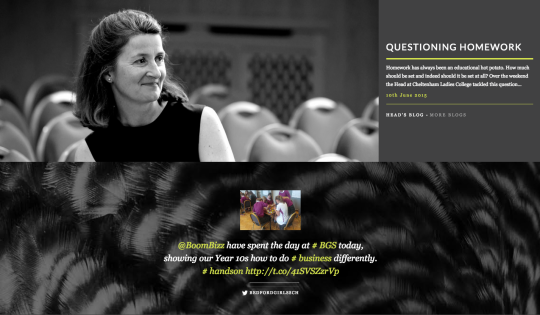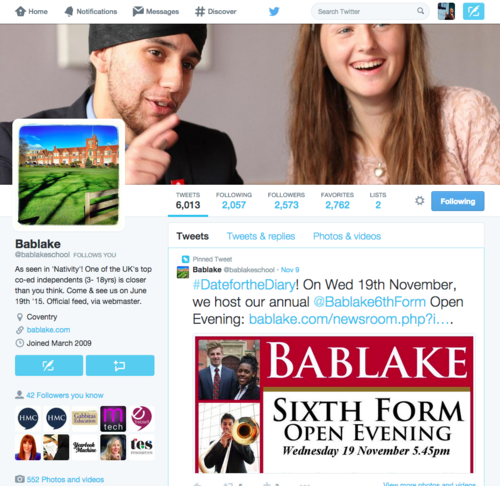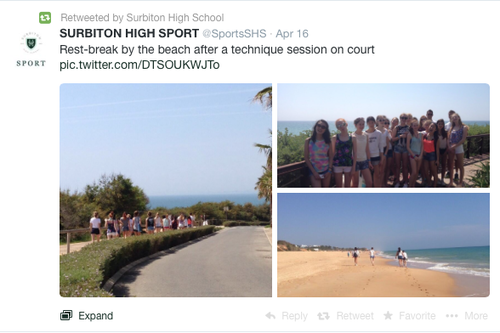25 Tweets to Send Before Christmas #SocialAdvent 2015
Nov 25, 2015 4:23:00 PM / by Interactive Schools Blog posted in social media, Twitter
Bold and Innovative Ways to Use Social Media in Lessons #EducationDay
Oct 13, 2015 3:19:33 PM / by Interactive Schools Blog posted in social media, Pinterest, Twitter, learning, snapchat, facebook
People mistake social media for socialising. WRONG. People do socialise on social media, but that's just a tiny part of how we use social.
Social is used for learning, collaboration, productivity, writing, curation, entertainment, storytelling. Not just socialising with friends.
Students natively use social media to communicate, curate, and share ideas online.
As teachers, this gives you a great opportunity to increase their passion for learning. Giving access and implementing strong educational resources is a great way to engage students both inside and outside the classroom.
It’s important to incorporate your lesson materials using this new medium. It reaches students through a medium they use everyday. And it also chronicles all the tips, lessons and answers you provide in your stream.
Finding bold and innovative ways to use social media is a great way for your school to progress into this new generation. These are just a few ideas that you can infuse social media into your lesson plans to.
Using Snapchat for Quizzes
Schools are seriously misunderstanding Snapchat, and how people use it. Snapchat is trying to replace TV. It understands that people are moving away from tradition television into YouTube, Netflix, and other mobile channels.
Big media companies (Sky, Daily Mail, National Geographic) have set up their own channels on Snapchat because they understand that's where people are spending their time looking for entertainment.
Because of Snapchat's ephermal nature, teachers can use it for memory quizzes. Simply set the time (1-10 seconds) that you want the image or video to appear, and publish your story to Snapchat.
The Power Of School Stories
Sep 3, 2015 10:23:20 AM / by Interactive Schools Blog posted in social media, Twitter, Flickr, youtube, vine, snapchat, facebook
“We owe it to each other to tell stories.” – Neil Gaiman
From a very young age people are taught such infamous childhood fables as The Boy Who Cried Wolf, The Hare and the Tortoise and The Goose that laid the Golden Eggs.
These fables originate from 620BC and are still taught in schools today!
How many still remember these famous fables? Almost everybody will remember at least one of these infamous fables.
Storytelling began on cave walls and has travelled through time passing through rock art, hieroglyphics, painted artefacts, and has now entered the modern era with social media.
Snapchat, Facebook, Twitter, Vines have stories captured and shared every day. Storytelling hasn’t changed - but the channels we tell them via have evolved.
(The Hare and the Tortoise 1700-2015)
5 ways for schools to engage with parents on social media
Jun 17, 2015 1:25:16 PM / by Interactive Schools Blog posted in social media, Twitter, blogging, facebook
Great things happen when parents get involved in their child’s education. Not only does the school benefit from the support, but research shows [1] that it even helps academic achievement.
Unfortunately, traditional forms of parental engagement (e.g. Parent-Teacher conferences or sending a note home) don’t make much of an impact these days.
And yes, you can blame the Internet for this disruption.
These traditional methods still add some value. But that number is waning as more of the population becomes dependent on digital communication. Things like Facebook and Twitter aren’t restricted to the younger generation anymore.
Getting active on social media platforms gives your school unparalleled access to parental engagement. It’s time to embrace this powerful technology. Are you ready?
1. Reach Out to Parents
First things first, make sure to let the parents know about your social media plans. Send a letter home or shoot off an email blast with an announcement of this new engagement strategy.
It’s about getting them involved. Your efforts won’t go very far if you don’t let parents know your intentions. Getting them informed from the beginning helps ensure the success of your social media efforts for the school.
How schools are ALREADY doing this:
Haberdashers’ Aske’s School for Girls uses beautifully designed HTML email newsletters to send parents updates with what is happening - their latest news, photos, videos, tweets.
These dynamically pull through from their content/social channels. You mean to say they don’t spend hours putting this all together? That’s right. 10 mins. Max.
Notice at the bottom: connect with us.
This is parent engagement.
Distributing short videos
Mar 4, 2015 6:33:59 PM / by Interactive Schools Blog posted in meerkat, Instagram, Twitter, youtube, vine, snapchat, facebook
Short form video has exploded recently. With faster 4G speeds, better cameras, and more storage on smartphones, videos have become popular on social media.
A modern parent expects visual storytelling from their school.
Visuals started to be included in posts to make them stand out. But now, everybody does it. Short video has almost become the new photo. Want to stand out? Try posting short videos.
Here are some of the main channels you can use:
As you can see, there are a lot of places you can distribute your short video. So look at the benefits of uploading video to each channel and use this mini-guide to help inform your decision.
YouTube
Second largest search engine in the world. Biggest reach when it comes to video.
Short-form video is not native to YouTube - it was designed, and is being used, for longer form.
Share to YouTube if your video is over 1 minute.
Vine
Vine is designed for creating 6-second videos on mobile. So it is native for distributing short video.
The restrictive nature of Vine forces you to be creative with your posts. Which has led Vine to be popular with people who want quick entertainment.
Posts can easily be embedded into tweets, and websites to increase your reach.
Instagram has a huge audience of over 300 million people. It is a mobile-first platform, meaning it is designed to capture events through your smartphone.
There is a 15 second limit on videos.
Share artsy and indie photos to engage the Instagram crowd. Don’t put adverts, or text based content up.
A video posted by bablakeofficial (@bablakeofficial) on
Facebook has the largest audience, second only to YouTube. But, it is not a video specific channel.
Facebook autoplays videos in a person’s feed. Though this is great for grabbing attention, it also inflates the number of views a video has had in Facebook Insights.
Facebook videos are for short-medium form video. No real purpose for Facebook videos - other than to be more of a competitor to YouTube.
Sharing videos on Facebook, from YouTube, creates a link post. This pulls through meta data from YouTube, and isn’t as effective or attention-grabbing as native Facebook video. Also means it requires more clicks to play the video.
Videos can be uploaded once they have already been taken. This allows you to capture moments and share them at the end of the day.
If you have time to upload videos to Facebook, then go for it. If not, share it to YouTube.
Twitter is naturally all about short storytelling. The strict limitations on Twitter enables you to share quick micro-content.
It has recently introduced video to tweets, with a 30 second limit.
Twitter owns Vine. The difference? Vine is a creative way to tell your story. Twitter is the real-time way to tell your story.
You can now shoot, edit and share video on Twitter. Capture life’s most moving moments from your perspective. pic.twitter.com/31JoMS50ha
— Twitter (@twitter)
Snapchat
Mobile video is native to Snapchat. It allows you to capture a moment, as it is happening, and share it to your ‘story’. Your story is a collection of photos and videos capture with Snapchat in the past 24 hours.
There is a 10 second limit for each video but you can piece them together in your story.
Snapchat is more like the front of a postcard, where Twitter is the back.
Meerkat (NEW)
Meerkat is a live broadcasting platform that allows you to stream video through Twitter. It literally went live 6 days ago (that’s how quickly we react for you guys!).
The platform is all about sharing live stories. How can you get more real-time than that?!
Take a look at it and explore it. What do you think?
There are clear pros and cons for distributing short videos on particular channels. You can repurpose videos to work for each channel - but only if they work with the style of each channel.
QUESTION OF THE DAY: If you could only upload your latest video to ONE channel, which would you choose and why? TWEET US: @intSchools
Social Media Training Day #SMTD15
We’re offering a social media day for school marketers to learn more about social media marketing. Come and join us on 28th April 2015 at Whittlebury Hall, Northamptonshire.
Learn about reach, social influence and the importance of your digital brand.
Twitter vs Facebook: Which one should you be using?
Nov 20, 2014 10:57:00 AM / by Interactive Schools Blog posted in Twitter, facebook
This post is split into two parts:
Twitter vs Facebook: PART ONE
Twitter and Facebook are often seen as the same type of channel, of which only one is relevant - ‘you should be on either Twitter or Facebook’. This is simply not true. In short, you should be on both.
Appearance-wise, they may look similar. Both have a profile picture, header image, description, links, timeline etc. But they each offer their own set of benefits and type of communication and language.
We’ve split this blog post up into two parts. [Part One] will explore the basics of the channels, and what differentiates them. [Part Two] will be a more advanced look into Twitter and Facebook - types of content, ways to advertise, psychology of users, demographics etc.
Twitter is a microblogging service that allows users to share bursts of information, known as tweets, in 140 characters or less. It has developed into a great platform to engage with prospects and current communities. Schools can use the service to show all of things happening at the school, in real-time.
That’s the key here. Twitter is all about real-time communications - what is currently happening at the school.
Twitter has becoming much more visual in its appearance. Photos and videos are being integrated into tweets much more frequently. And we are seeing more engagement with tweets that contain photos. Twitter now allows you to upload up to four photos into a single tweet.
With over 271 million active users, it is still a small but effective community for schools to use.
Facebook is the worlds largest social network, with over 1.3 billion users. The ability to develop a community on the platform is incredibly powerful. Schools should be using the platform to enhance brand, voice and community.
Facebook’s Timeline is designed to visual show photos, videos, links and other media.
The purpose of the channel is to develop a community that will advocate your school’s brand to increase awareness and publicity. This can be achieved by sharing content that resonates with the current community.
Your Facebook Page will also offer a place for prospects to discover what life at the school is like, through statuses, photos, videos and comments.
It should be used to showcase all of the great things that happen at the school.
Real-time vs Archive
What’s happening?
Twitter is your what’s happening channel. This is what is currently going on at the school, with posts and activity from the diverse range of interests and activities at the school - sports, drama, music, art, science etc.
People in Twitter mode are fast-paced and what information now.
This is your place to tell every story that is currently developing at the school.
A good example is Bablake School - https://twitter.com/bablakeschool
What’s happened?
Facebook is your what’s happened channel. This is where you showcase the best things that have happened recently. Not all stories will be told on Facebook, but the most exciting ones will be.
People on Facebook are in down-time and likely to be in consumption mode at the end of the day.
This is your place to tell the best stories that have happened today.
Take a look at how Bablake School do it - https://www.facebook.com/bablakeschool
Twitter vs Facebook: PART TWO
Read - Twitter vs Facebook: Which one should you be using? PART ONE
In December, we explored the differences between Twitter and Facebook, and how this affects your school’s marketing. We’re now going to look deeper into who uses them, and how people use these two channels.
Demographics
71% of adult internet users // 58% of entire adult population.
Facebook is still, by far, the most popular social network. However, growth has slowed (kinda inevitable when you have so many users already!) over the past year. Other platforms have seen large growth.
The only group to be growing fast on Facebook? The ‘over 65s’.
A list of who people ‘friend’ on Facebook:
- 93% of Facebook users say they are Facebook friends with family members other than parents or children
- 91% say they are Facebook friends with current friends
- 87% say they are connected to friends from the past, such as high school or college classmates
- 58% say they are connected to work colleagues
- 45% say they are Facebook friends with their parents
- 43% say they are friends with their children on Facebook
- 39% say they are connected to people they have never met in person
- 36% say they are Facebook friends with their neighbours
Facebook is surprisingly the most popular sharing platform for ‘personally created videos’. These are videos that people have taken on their smartphones, cameras etc.
Data via Pew Research Centre.
http://www.pewinternet.org/2015/01/09/demographics-of-key-social-networking-platforms-2/
Psychology of user
Facebook has been built to be a timeline of your life. From the moment you are born, they want people to be sharing your story.
It has always been about closed connections, whereby friendship and an acceptance of request is needed. Tagging, liking, commenting, sharing… The life of Facebook is about sharing the lives of you, your friends, and your family.
Who do you connect with on Facebook?
- Friends
- Family
Can you like brands, companies, organisations? Yes, of course. But would you say it is a connection? Probably not. People only Like brands for the discounts. Am I right?! Well, kinda. Here’s the real deal about why people become a fan of brands on Facebook:
Celebrities and public figures were introduced to Facebook - and yes, people Like or subscribe to them. But do they really ‘connect’? No, not really. It is more one-way communication.
Interactions with other accounts are much more likely on Twitter. Take a look at some of the most popular UK accounts below, and notice how popular accounts are interacting.
Harry Styles
Twitter seems to have much more open-interactions. And this is clearly due to its open nature.
Want to see how schools (or anyone!) are interacting on Twitter? Hit the 'Tweets & replies’ button to see.
Twitter vs Facebook in Numbers [INFOGRAPHIC] via Forbes
Keeping your school's brand consistent on Twitter
Jun 17, 2014 5:13:00 PM / by Interactive Schools Blog posted in Twitter
With more and more schools using Twitter with multiple accounts, there is the worry that your school identity may become fragmented on the channel.
The idea is that schools are wanting to provide a more tailored communication, based on interests and communities. And we’re seeing more and more schools adopting this approach.
This means that people can follow specific accounts of the schools that they are interested in. For example, a parent or pupil may want to follow the sports, arts, boarding house, and trips accounts.
Even if you do not plan on using the account at this time, there is the benefit of reserving your brand names for future purposes.
Take a look at these examples of how schools have multiple sub-accounts:
A Twitter search for Surbiton High School:
https://twitter.com/search?q=surbiton%20high%20school%20&src=typd&mode=users
A Twitter search for Wellington College:
https://twitter.com/search?q=wellington%20college&src=typd&mode=users
Naming
The clearest solution is to ensure your Twitter handles abide by naming conventions. An example could be that you initialise your school name to form your collection of Twitter handles.
Surbiton High School use this method effectively. Their accounts often use the abbreviation of SHS.
NameChk is a very useful tool to determine the availability of username on many social media channels.
Lists
Lists are a great way for schools to organise their followers. A list of official accounts can be created to show all the school’s official Twitter accounts. Simply create a list, and add your accounts as members. You can then link to the feed, or members list, on your website and other social channels.
An example from Bablake School:
https://twitter.com/bablakeschool/bablake-twitter-sites/members
BBC have also used lists very well, as they have hundreds of associated accounts.
Although lists are a great idea and very useful, there is the issue that lists are not well known or highly visible. Lists are hidden behind the ‘More’ button on your profile.
Following
Another option is to only follow your official Twitter accounts. Of course, you should be following them anyway, but they may be lost in a feed of hundreds of other accounts you follow.
Header Image
Header images can be used to either add it your official accounts, or to add an ‘official badge’ to denote that the account is related to the school.
Tweeting
Yep, this is pretty simple. But it is very effective to retweet and tweet your sub-accounts. This creates awareness as somebody may not be aware of a certain sub-account, but by retweeting or tweeting to that account their visibility increases.
Description
There is the option to add a URL to your Twitter profile but this should be used to link to your school website. You can use your Twitter description to add in the link to your list of official accounts.
How does your school manage, and promote, multiple Twitter accounts? Let us know in the comments.
Does your school require training on social media? Book a social media training day with us!
How to use Twitter's pinned tweets
May 21, 2014 3:04:00 PM / by Interactive Schools Blog posted in Twitter
Pinned tweets offer the ability to pin a tweet to the top of your profile. This means that when somebody visits your profile, a ‘marketing tweet’ can the first and most visible.
This is important because a lot of people will click onto the Twitter link on your website, which links to your profile page. Previously, this would have brought up all of your most recent tweets. This isn’t the most engaging because, possibly, your three most recent tweets may not have been ‘exciting’.
What types of tweets you can pin:
- Next open days
- Latest news article or blog post
- The most engaging tweet of the week
There are also a couple of other types of tweets which are important for you to understand:
- Best tweets
- Filtered tweets
Best tweets
Tweets that receive more engagement appear larger in size. This makes your engaging tweets more visible.
Filtered tweets
Twitter has started to increase the visibility of the different types of media on offer - tweets and photos/videos.
This means that you can filter tweets by those that are just copy, and those that contain photos and videos. And with Twitter becoming more and more visual, this is only going to become more important.
How to pin your tweets
1. Select the three dots icon to open up the ‘More’ menu.
2. Select ‘Pin to your profile page’
3. Hit ‘Pin’ to pin your tweet
4. Now your tweet has been pinned to your profile. Now take a look at how it appears
5. Your tweet now appears at the top of your profile, and has the ‘PINNED TWEET’ icon/copy
Has your school introduced pinned tweets? How do you use it? Let us know in the comments, or tweet us @intSchools!
Found this blog post useful? Great! It’s just one of the things we will go through when we come and train your school on using social media effectively.
Top 10 BSA Schools on Twitter Table
May 11, 2014 8:24:00 PM / by Interactive Schools Blog posted in Twitter

Make sure your tweets include a photo
Apr 25, 2014 12:16:00 PM / by Interactive Schools Blog posted in Twitter
four photos at a time, and tag up to 10 people.







